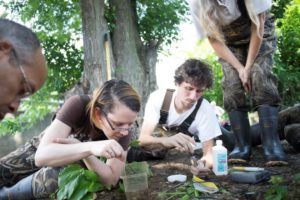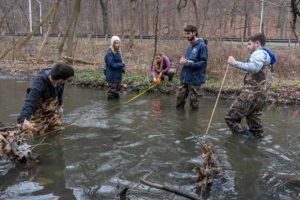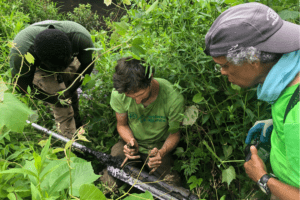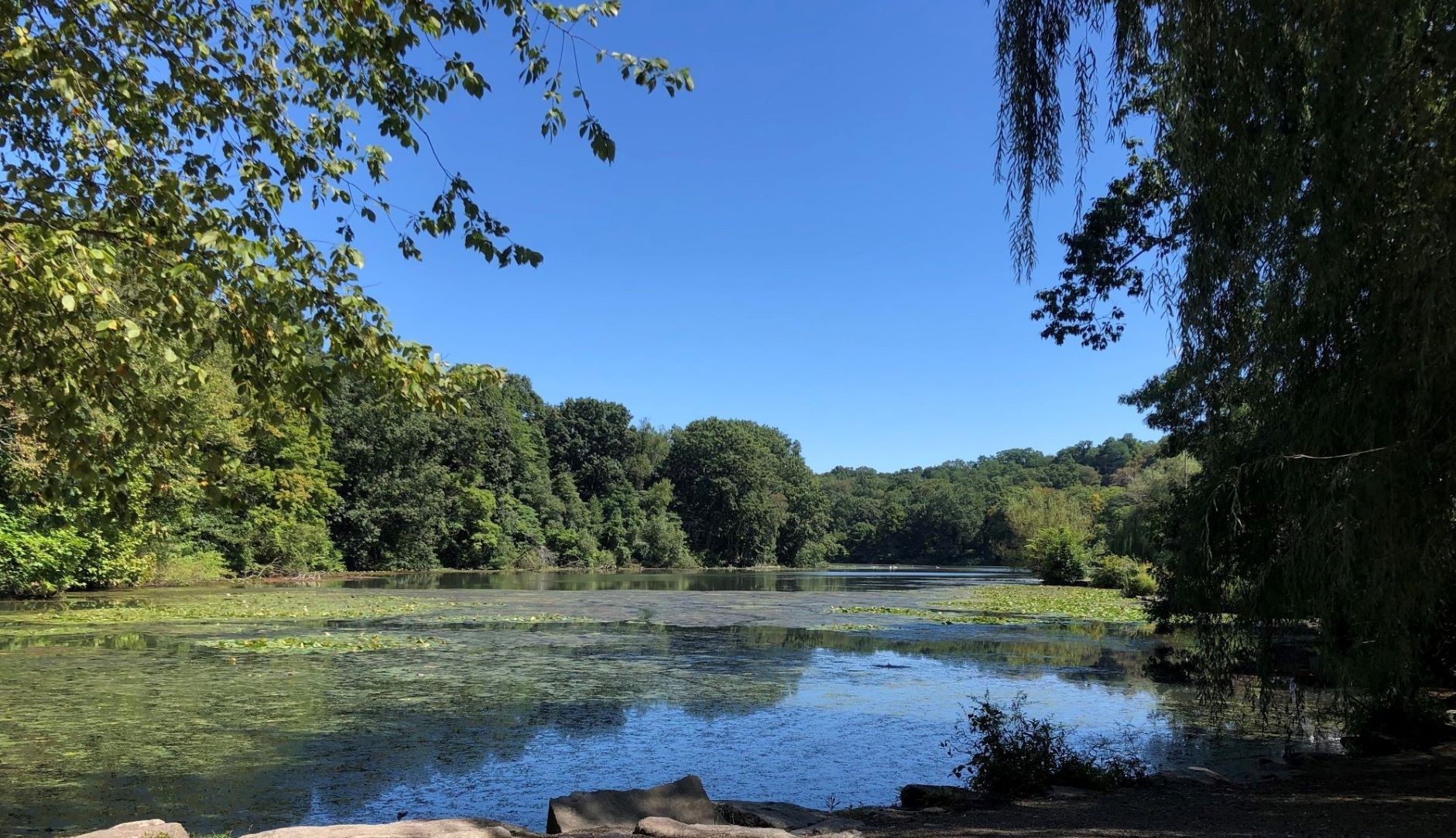Research Projects



Scientific data is essential for the proper management of urban natural areas. The Van Cortlandt Park Alliance staff scientist leads multiple research teams conducting several ongoing projects in the natural areas of Van Cortlandt Park to better understand the water chemistry, geochemistry and biological diversity of the park. Thus far data collected has revealed discoveries that include new documented species for our region, the generation of predictive models for forest ant communities, the novel application of decision analysis to water quality monitoring, documenting the enrichment of titanium in our forest soils and a detailed statistical analysis on Tibbetts Brook biodiversity linking water chemistry to species diversity of benthic macroinvertebrates.
Background: Starting in late 2015 research was undertaken to understand the water quality of the freshwater ecosystems of VCP. The purpose of the study was to provide baseline data of Tibbetts Brook water quality for a series of years that allows for the expansion of research along the brook, as well as insight into management of the brook and lake within Van Cortlandt Park. During the study, we sampled 9 distinct sites along Tibbetts Brook (4 sites in Yonkers, 5 in Van Cortlandt Park). The sampling occurred on a biweekly basis.
Projects include: Eutrophication classification, Nutrient dynamics and Optimal sampling protocol.
- Published paper – Abbatangelo, J., Byrne, A., Butler, J. F., & Wilson, J. M. (2019). Application of multi-criteria decision analysis to assess sampling strategies in eutrophic urbanized waterbodies. Environmental monitoring and assessment, 191(9), 1-11.
- Technical report – Tibbetts Brook Water Monitoring Program Report of 2016 Water Quality Data
- Conference presentation – EWRI World Environmental & Water Resources Congress
- Conference poster – 2018 Water Quality Poster
- Conference poster – Determination of Heavy Metals in Tibbetts Brook
- Dataset – Water Quality Master Dataset
Collaborators and Support:
Dr. Jessica Wilson – Manhattan College Department of Environmental Engineering
Dr. Yelda Hangun-Balkir – Manhattan College Department of Chemistry and Biochemistry
Dr. Paul Mankiewicz – The Gaia Institute and Leaf Island
Bronx Council for Environmental Quality
National Fish and Wildlife Foundation
Environmental Protection Agency
NYS Department of Environmental Conservation
Background: Urban watersheds are hosts to a series of stressors on rivers and streams including sedimentation, nutrient and pollutant loading, and channelization (Lenat & Crawford, 1994). These stressors alter freshwater biological communities, leading to a reduction in biotic richness and ecosystem functionality, a process known as the “urban stream syndrome” (Walsh et al. 2005, Allan 2004, Riseng et al. 2006, Gregory and Calhoun, 2006). The objective of this work is to determine whether commonly captured water quality parameters can predict changes in a BMI community.
Projects include: Modeling the drivers of benthic macroinvertebrate diversity with water quality data, Population studies of freshwater invertebrates with high impact ecosystem services and Comparative community structure of Tibbetts Brook and the Bronx River.
- Conference presentation – 2021 EWRI Congress Presentation Chemical drivers of freshwater invertebrate community and population dynamics within a small urban river.
- Conference poster – 2019 Wave Hill Mentorship Crayfish Ecology
- Species list – 2016-2019 Hester and Piero’s Mill Pond and Tibbetts Brook Taxa List
- Presentation – Benthic macroinvertebrates of freshwater ecosystems in New York City
- Dataset – 2018 Enterococcus Data for Hester and Piero’s Pond
- Dataset – 2019 Matrix Dataset for Benthic macroinvertebrates
Collaborators and Support:
Dr. Jessica Wilson – Manhattan College Department of Environmental Engineering
Dr. Mathew Lundquist – Marymount Manhattan College Department of Natural Sciences
NYS Department of Environmental Conservation
Background: Urban parks are one of the best studied habitats within human dominated landscapes, yet restricted by the costly time consuming practice of basic survey work, urban parks across the United States lack park level data of the composition, abundance and distribution of fauna such as invertebrates (McIntyre 2000). Biodiversity knowledge of urban parks that incorporates multiple trophic levels will favor a scientific based management style, which necessitates the understanding of animals with high impact services to the ecosystem. This research elevates our understanding of the biogeography of species composition across the park that will help restoration efforts by pairing the structural complexity of the environment generated by planting native plants with the biodiversity necessary for its persistence. In addition, with the use of geographic information systems, mapping of all of the parks biodiversity has begun to aid in restoration activities.
Projects Include: Community ecology of Forest arthropods, Taxonomy of Hymenoptera of Van Cortlandt Park, Trophic ecology of VCP Ants.
- Dataset – 2018 Ant Community Matrix Data
- Species list – 2016 Species list Bees and Wasps VCP Gun Hill Meadow
- Join our iNaturalist project – Van Cortlandt Park Biodiversity Project
- iNaturalist Biodiversity Maps
- Manually Creating Shapefiles from iNaturalist observation data tables
- Using Python code to create point shapefiles from iNaturalist observation Data Tables
Collaborators and Support:
Open Space Institute McHenry Awards 2018
National Environmental Education Foundation
Parker Gambino- AMNH
Christian Liriano – AMNH Lab Research Assistant
Tim Wheeler – University of Rouen
Joshua Albrecht – CUNY Lehman College
Dr. Brian Haney – College of Mount St. Vincent Division of Natural Sciences
Background: Ecological services of urban forests, such as air and water filtration, carbon storage and stormwater capture, are closely linked with physical and chemical properties of soils (Chiesura 2004). Additionally, pollutants in urban soils also affect urban biodiversity (Nriagu 1990). Therefore, there is a need to measure chemical composition of soils and understand their role in the development of ecologically productive natural areas within cities, composed of native biota and unpolluted environments (Chiesura 2004).
Projects include: Geochemistry of forest soils.
- Conference poster – 2019 American Geophysical Union Elemental composition of soils in an urban park: Strategies for conservation and management.
- Dataset – 2019 XRF Soil Master Dataset
Collaborators and Support:
Dr. Yuri Gorokovich – CUNY Lehman College Department of Earth, Environmental, and Geospatial Sciences
Urban Soils Institute
Background: Human dominated habitats such as cities are typically subjected to intense disturbance which results in ecosystems that have been altered from their original state. The practice of returning these sites to function as they once were is the process of ecological restoration. Within VCP, invasive plants have altered plant communities with current research aimed at understanding the population status of certain invasives and developing techniques for successful restoration. In addition investigations into the role of freshwater mussels in aquatic restoration are ongoing, exploring the ways aquatic organisms can be used to improve water quality in eutrophic waters.
Projects include: Solarization of Japanese Knotweed invaded patches, application of freshwater mussels to freshwater restoration, mycoremediation and the population biology of waterchestnut.
- Conference presentation – 17th NYC Restoration Practitioners Meeting – Restoring invaded patches using thermal stress: Japanese Knotweed reduction via solarization
- Conference presentation – 2019 EWRI Conference – Ecological filtration systems: Using freshwater mussels to reduce pollutants
- Conference poster – The presence and removal of a heavy metalloid pollutant in New York surface waters using rhizofiltration.
- Research mentorship – Mycellium propogation in various mediums and applications in asphalt decomposition
Collaborators and Support:
Groundwork Hudson Valley Green Team
VCPA Summer Field Staff
Evans Kyei, Ecologist and NYC Parks Forester
NYS Department of Environmental Conservation 2019 Invasive Species Grant Program
Dr. Jessica Wilson – Manhattan College Department of Environmental Engineering
Background: Urban natural areas are designed for the benefit of both humans and non-human organisms. Therefore we have conducted research to better understand the role of the human element within park spaces. Additionally, this research also sought to better understand stakeholder opinions, including the public.
Projects include: Stakeholder surveys for understanding park use.
Collaborators and Support:
Bronx Council of Environmental Quality
Background: Understanding the historical dynamics of temperature, precipitation, geochemistry and biological populations is necessary for accurately predicting future changes to ecosystems. The use of paleoecological techniques that analyze wetland and lake sediments is a powerful tool for park managers, however it is greatly under utilized. By analyzing sediment cores from the park we have begun to better understand the ecological history of VCP and the northwest Bronx.
Projects include: Historical Diatom assemblages of Tibbetts Brook, Tracking Historical Pollution and reconstructing historical plant communities using pollen
Collaborators and Support:
NYS Department of Environmental Conservation
Dr. Dorothy Peteet Lamont Doherty Earth Observatory
Van Cortlandt Park Alliance online data are freely available for downloading and subsequent use. Users are asked to comply with the following Use Statement:
This dataset is released to the public under Creative Commons CC0 1.0 (No Rights Reserved). Please keep the dataset creators informed of any plans to use the dataset. Consultation with the original investigators is strongly encouraged. Publications and data products that make use of the dataset should include proper acknowledgment.
Contact: info@vancortlandt.org
The VCPA curates a number of specimen collections.
For access to collections please contact: info@vancortlandt.org
Collections include:
(Wet) 2019 Benthic macroinvertebrate of Tibbetts Brook and Hester and Piero’s Mill Pond
2017-2019 Ants of the Northwest Forest, Croton Woods, Flood Plain Forest and Vault Hill
“We are drowning in information, while starving for wisdom. The world henceforth will be run by synthesizers, people able to put together the right information at the right time, think critically about it, and make important choices wisely.”
Dr. E.O. Wilson


